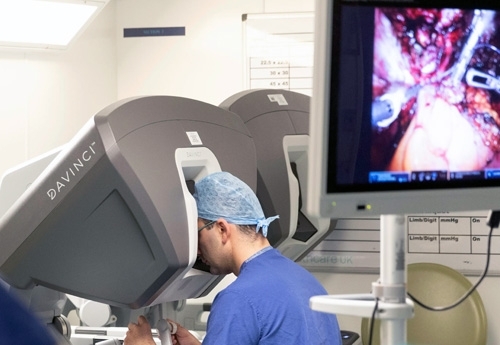Like laparoscopic surgery, this surgical system involves inserting robotic arms through approximately 1 cm incisions in the surgical area. These are maneuvered using a console, providing excellent visualization of all structures thanks to high-resolution, three-dimensional imaging.

Robotic surgery, originating from the idea of remote surgery for wounded soldiers by the US Department of Defense, has become the gold standard for open and laparoscopic surgeries, particularly in urology, following FDA approval in 2000.
In da Vinci robotic surgery, the surgeon performs the surgery. The robot provides the surgeon with better visualization, fewer incisions, less bleeding, and a more comfortable surgery. Ultimately, the patient receives the most significant benefit.
In general, surgeries performed with the da Vinci robotic system are at least as safe as alternative open or laparoscopic surgeries. Studies have shown that many surgeries result in less blood loss, making them safer in this regard.
In modern countries where robotic surgery is practiced, the da Vinci robotic system was initially used primarily for radical prostatectomy, which is typically a prostate cancer surgery. It has since been applied with high success in bladder cancer, kidney cancer, adrenal cancer, and testicular cancer surgeries. It has also rapidly become widespread in colorectal and stomach cancers, gynecological cancers (uterine cancer),and some types of chest and cardiovascular surgery.
Thanks to three-dimensional and high-resolution imaging, all anatomical structures are visualized more clearly. Surgical instruments mounted on robotic arms, which can move in all planes, allow for better suturing and prevent hand tremors from being transmitted to the instruments. Robotic arms, with a 540-degree angle, allow for greater rotation than human hands. This feature provides advantages over both laparoscopy and open surgery.
Robotic surgery is a more minimally invasive procedure than open surgery. This means:
Da Vinci robotic surgery has gained popularity, particularly with its successful results in prostate cancer. Robotic radical prostatectomy has become the gold standard for the treatment of non-metastatic prostate cancer because it allows for faster resolution of urinary incontinence and erectile dysfunction.
In a large-series multicenter study, the 15-year survival rate of patients who underwent robotic radical prostatectomy for localized prostate cancer was recorded with an excellent success rate of 97%. In the urological field, it has made a difference in partial nephrectomy surgery in terms of tumor removal and suturing of other tissues compared to open and laparoscopy.
Da Vinci robotic cancer surgeries (prostate cancer, bladder cancer, and kidney cancer) are performed by urologist Assoc. Prof. Dr. Arif Demirbaş at Doruk Nilüfer Hospital in Turkey. Our hospital is in the JCI accreditation process and is an internationally certified healthcare center.
Prices for robotic radical prostatectomy, the gold standard in prostate cancer treatment, vary depending on the patient's insurance status, the stage of the disease, the hospital's physical condition, and the surgeon's experience. The average cost is around $10,000-13,000 for Da Vinci robotic prostatectomy in our center.
For more information, WhatsApp: +905324850016
Prices for robotic radical nephrectomy and robotic partial nephrectomy, which are effective surgical methods for treating kidney cancer, vary depending on the patient's insurance status, the stage of the disease, the hospital's physical condition, and the surgeon's experience.
Is radical nephrectomy, which removes the entire kidney, or robotic partial nephrectomy, which removes only the mass while preserving normal tissue, more suitable? The answer to this question plays a significant role in the cost. The average cost of robotic kidney cancer surgeries and kidney removal surgeries (partial or totatl) in our hospital is around 7000-10000 dollars.
Da Vinci robotic trocars (tubes) are inserted, typically through 4-5 1-cm incisions at the navel. Then, robotic arms equipped with fine instruments are inserted into the abdomen, providing three-dimensional imaging and separating the prostate from surrounding tissue. Robotic arm instruments are available that provide superior bleeding control. After the prostate is removed, the bladder and urethra are sutured together to complete the procedure.
Robotic arms, which can rotate 540 degrees, ensure precise suturing, allowing for early urinary continence. Furthermore, superior visualization allows for nerve preservation (nerve-sparing surgery) to better preserve erectile function.
The latest technology in prostate cancer surgery is radical prostatectomy performed with a robotic system. The world pioneer of these robotic systems is the US-based Da Vinci robot.
For more information, WhatsApp: +905324850016
- I will definitely recommend this hospital in the future.
- I cannot recommend Dr. Arif Demirbaş enough.
- God continue to bless you in all your good work.
All TestimonialsMeet Alpha from Sierra Leone who just undergone a PCNL and Utereoscopy surgeries at the Doruk hospital in Bursa. I want to start by sending a massive thank you to Dr Arif for exhibiting such a {...}
24.01.2025I cannot recommend Dr. Arif Demirbaş enough. My father had been living with a catheter for over two years due to benign prostatic hyperplasia, which also caused bladder stones and an inguinal h{...}
24.01.2025Thanks to you Dr Arif for your successful kidney stone surgery on my Son Ryan since after we came back from Turkey to date Alhamdulillah Ryan is very ok Alhamdulillah bravo for your Good work. {...}
24.01.2025